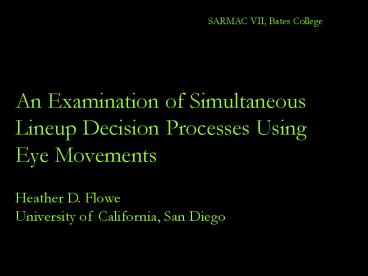An Examination of Simultaneous Lineup Decision Processes Using Eye Movements - PowerPoint PPT Presentation
1 / 18
Title:
An Examination of Simultaneous Lineup Decision Processes Using Eye Movements
Description:
... made to individual faces faster are when the face is rejected compared to picked ... Inclusion of distractor faces at test decreased target face inspection time ... – PowerPoint PPT presentation
Number of Views:58
Avg rating:3.0/5.0
Title: An Examination of Simultaneous Lineup Decision Processes Using Eye Movements
1
An Examination of Simultaneous Lineup Decision
Processes Using Eye Movements
SARMAC VII, Bates College
Heather D. Flowe University of California, San
Diego
2
Face Processing in Lineups
Background Method Results Conclusion
- Relative versus Absolute Judgment Theory
- (Lindsay Wells, 1985)
- Deliberative versus Automatic Processing Theory
- (Dunning Stern, 1994)
3
Face Processing in Lineups
Background Method Results Conclusion
- Response Latency and ID Accuracy
- Shorter decision times associated with accurate
IDs (Sporer, 1994) - Information for faces that match memory
accumulates faster than for nonmatches - But When lineup presented sequentially,
responses made to individual faces faster are
when the face is rejected compared to picked
4
Overview of the Current Project
- Examine face processing times in lineups by
recording eye movements - Test whether Van Zandts Race Accumulator Model
of Recognition Memory can account for dwell time
differences across faces based on similarity of
the lineup face to the study face
Background Method Results Conclusion
5
Van Zandts Model (2000)
Background Method Results Conclusion
6
Predictions
- Response times for target identifications will be
faster than for foil identifications. - Dwell times for a rejected foil face will be
shorter compared dwell times for a positively
identified foil or target face. - Incorrect foil identifications will be
accompanied by a larger number of return visits
and longer return visit dwell times.
Background Method Results Conclusion
7
Design
Target presented in a lineup
Study Phase
Study Phase
Background Method Results Conclusion
Study Phase
Target presented alone
8
Stimuli
Background Method Results Conclusion
9
Measures
- Independent Variables
- ID outcome (suspect, foil, or lineup rejection)
- Target Condition (present or absent)
- Face type (suspect or foil)
- Dependent Variables
- First visit dwell time
- Return visit dwell time
- Number of face visits
Background Method Results Conclusion
10
ID Responses
Background Method Results Conclusion
Movie
11
ID Outcomes by Target Condition
Background Method Results Conclusion
12
First Visit Dwell Time and ID Outcome
Background Method Results Conclusion
13
Return Visit Dwell Time by ID Outcome
High Admonishment
Background Method Results Conclusion
14
Number of Face Visits by ID Outcome
High Admonishment
Background Method Results Conclusion
15
Summary
Background Method Results Conclusion
- Inclusion of distractor faces at test decreased
target face inspection time - Face dwell times predicted lineup responses
- Data were consistent with Van Zandts model
- Dwell times varied in relation to similarity of
face to target
16
Thank you!
Heather D. Flowe hflowe_at_ucsd.edu
17
Target Alone Identification Responses
Background Method Results Conclusion
18
Target Alone Face Type, ID Outcome and Dwell Time
Background Method Results Conclusion































